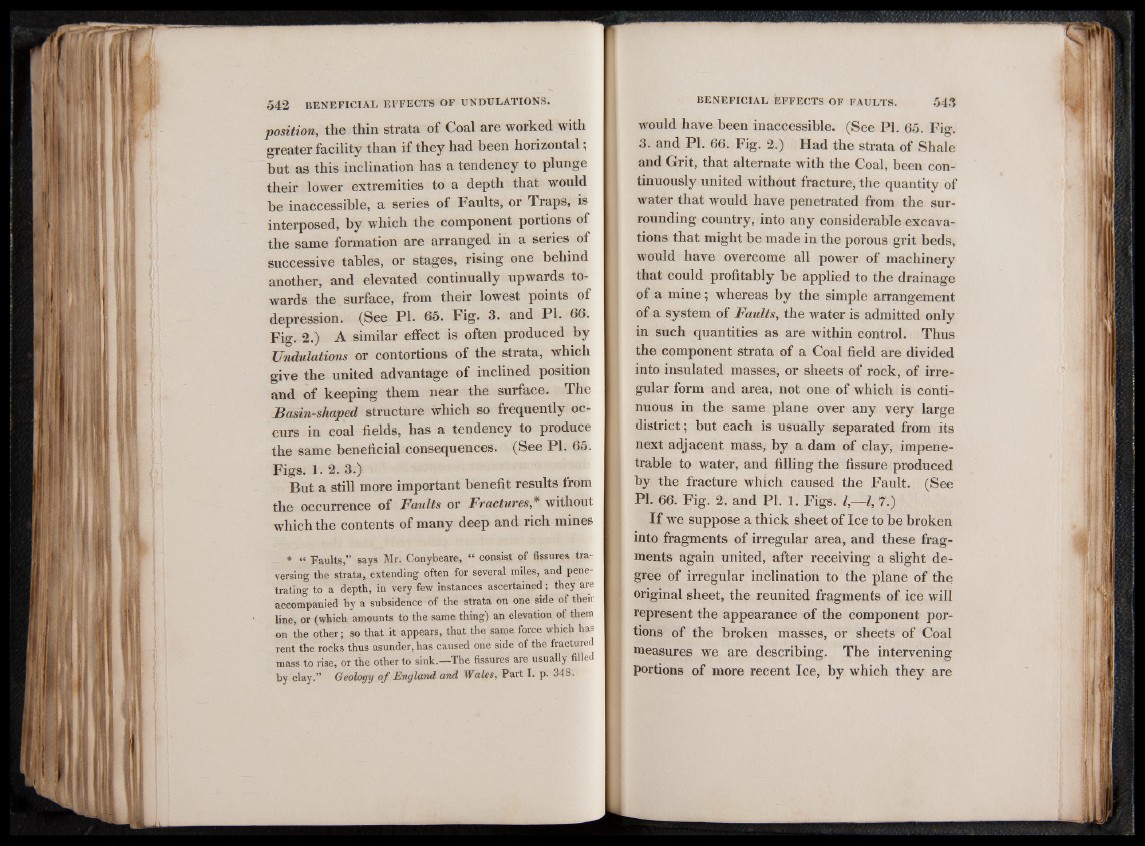
position, the thin strata of Coal are worked with
greater facility than if they had been horizontal;
but as this inclination has a tendency to plunge
their lower extremities to a depth that would
be inaccessible, a series of Faults, or Traps, is
interposed, by which the component portions of
the same formation are arranged in a series of
successive tables, or stages, rising one behind
another, and elevated continually upwards towards
the surface, from their lowest points of
depression. (See PI. 65. Fig. 3. and PI. 66.
Fig. 2.) A similar effect is often produced by
Undulations or contortions of the strata, which
give the united advantage of inclined position
and of keeping them near the surface. The
Basin-shaped structure which so frequently occurs
in coal fields, has a tendency to produce
the same beneficial consequences. (See PI. 65.
Figs. 1. 2. 3.)
But a still more important benefit results from
the occurrence of Faults or Fractures* without
which the contents of many deep and rich mines
* “ Faults,” says Mr. Conybeare, “ consist of fissures traversing
the strata, extending often for several miles, and penetrating
to a depth, in very few instances ascertained; they are
accompanied by a subsidence of the strata on one side of their
line, or (which amounts to the same thing) an elevation of them
on the other; so that it appears, that the same force which has
rent the rocks thus asunder, has caused one side of the fractured
mass to rise, or the other to sink.—The fissures are usually filled
by clay.” Geology o f England and Wales, Part I. p. 348.
would have been inaccessible. (See PI. 65. Fig.
3. and PI. 66. Fig. 2.) Had the strata of Shale
and Grit, that alternate with the Coal, been continuously
united without fracture, the quantity of
water that would have penetrated from the surrounding
country, into any considerable excavations
that might be made in the porous grit beds,
would have overcome all power of machinery
that could profitably be applied to the drainage
of a mine ; whereas by the simple arrangement
of a system of Faults, the water is admitted only
in such quantities as are within control. Thus
the component strata of a Coal field are divided
into insulated masses, or sheets of rock, of irregular
form and area, not one of which is continuous
in the same plane over any very large
district ; but each is usually separated from its
next adjacent mass, by a dam of clay, impenetrable
to water, and filling the fissure produced
by the fracture which caused the Fault. (See
PI. 66. Fig. 2. and PI. 1. Figs. I,— l, 7.)
I f we suppose a thick sheet o f Ice to be broken
into fragments o f irregular area, and these fragments
again united, after receiving a slight degree
o f irregular inclination to the plane o f the
original sheet, the reunited fragments o f ice will
represent the appearance o f the component portions
o f the broken masses, or sheets o f Coal
measures we are describing. The intervening
portions o f more recent Ice, by which they are